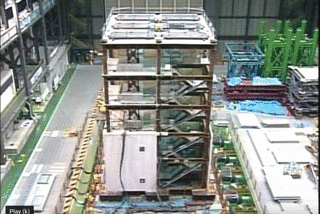PHOTO | 5 ways the moon landing changed life on earth
페이지 정보
작성자 지연 작성일19-07-19 22:02 조회451회 댓글0건관련링크
본문
nasa:
When Neil Armstrong took his first steps on the Moon 50 years ago, he famously said “that’s one small step for a man, one giant leap for mankind.” He was referring to the historic milestone of exploring beyond our own planet — but there’s also another way to think about that giant leap: the massive effort to develop technologies to safely reach, walk on the Moon and return home led to countless innovations that have improved life on Earth.
Armstrong took one small step on the lunar surface, but the Moon landing led to a giant leap forward in innovations for humanity.
Here are five examples of technology developed for the Apollo program that we’re still using today:
1. Food Safety Standards
As soon as we started planning to send astronauts into space, we faced the problem of what to feed them — and how to ensure the food was safe to eat. Can you imagine getting food poisoning on a spacecraft, hundreds of thousands of miles from home?
We teamed up with a familiar name in food production: the Pillsbury Company. The company soon realized that existing quality control methods were lacking. There was no way to be certain, without extensive testing that destroyed the sample, that the food was free of bacteria and toxins.
Pillsbury revamped its entire food-safety process, creating what became the Hazard Analysis and Critical Control Point system. Its aim was to prevent food safety problems from occurring, rather than catch them after the fact. They managed this by analyzing and controlling every link in the chain, from the raw materials to the processing equipment to the people handling the food.
Today, this is one of the space program’s most far-reaching spinoffs. Beyond keeping the astronaut food supply safe, the Hazard Analysis and Critical Point system has also been adopted around the world — and likely reduced the risk of bacteria and toxins in your local grocery store.
2. Digital Controls for Air and Spacecraft
The Apollo spacecraft was revolutionary for many reasons. Did you know it was the first vehicle to be controlled by a digital computer? Instead of pushrods and cables that pilots manually adjusted to manipulate the spacecraft, Apollo’s computer sent signals to actuators at the flick of a switch.
Besides being physically lighter and less cumbersome, the switch to a digital control system enabled storing large quantities of data and programming maneuvers with complex software.
Before Apollo, there were no digital computers to control airplanes either. Working together with the Navy and Draper Laboratory, we adapted the Apollo digital flight computer to work on airplanes. Today, whatever airline you might be flying, the pilot is controlling it digitally, based on the technology first developed for the flight to the Moon.
3. Earthquake-ready Shock Absorbers
A shock absorber descended from Apollo-era dampers and computers saves lives by stabilizing buildings during earthquakes.
Apollo’s Saturn V rockets had to stay connected to the fueling tubes on the launchpad up to the very last second. That presented a challenge: how to safely move those tubes out of the way once liftoff began. Given how fast they were moving, how could we ensure they wouldn’t bounce back and smash into the vehicle?
We contracted with Taylor Devices, Inc. to develop dampers to cushion the shock, forcing the company to push conventional shock isolation technology to the limit.
Shortly after, we went back to the company for a hydraulics-based high-speed computer. For that challenge, the company came up with fluidic dampers—filled with compressible fluid—that worked even better. We later applied the same technology on the Space Shuttle’s launchpad.
The company has since adapted these fluidic dampers for buildings and bridges to help them survive earthquakes. Today, they are successfully protecting structures in some of the most quake-prone areas of the world, including Tokyo, San Francisco and Taiwan.
4. Insulation for Space
We’ve all seen runners draped in silvery “space blankets” at the end of marathons, but did you know the material, called radiant barrier insulation, was actually created for space?
Temperatures outside of Earth’s atmosphere can fluctuate widely, from hundreds of degrees below to hundreds above zero. To better protect our astronauts, during the Apollo program we invented a new kind of effective, lightweight insulation.
We developed a method of coating mylar with a thin layer of vaporized metal particles. The resulting material had the look and weight of thin cellophane packaging, but was extremely reflective—and pound-for-pound, better than anything else available.
Today the material is still used to protect astronauts, as well as sensitive electronics, in nearly all of our missions. But it has also found countless uses on the ground, from space blankets for athletes to energy-saving insulation for buildings. It also protects essential components of MRI machines used in medicine and much, much more.
Image courtesy of the U.S. Marines
5. Healthcare Monitors
Patients in hospitals are hooked up to sensors that send important health data to the nurse’s station and beyond — which means when an alarm goes off, the right people come running to help.
This technology saves lives every day. But before it reached the ICU, it was invented for something even more extraordinary: sending health data from space down to Earth.
When the Apollo astronauts flew to the Moon, they were hooked up to a system of sensors that sent real-time information on their blood pressure, body temperature, heart rate and more to a team on the ground.
The system was developed for us by Spacelabs Healthcare, which quickly adapted it for hospital monitoring. The company now has telemetric monitoring equipment in nearly every hospital around the world, and it is expanding further, so at-risk patients and their doctors can keep track of their health even outside the hospital.
Only a few people have ever walked on the Moon, but the benefits of the Apollo program for the rest of us continue to ripple widely.
In the years since, we have continued to create innovations that have saved lives, helped the environment, and advanced all kinds of technology.
Now we’re going forward to the Moon with the Artemis program and on to Mars — and building ever more cutting-edge technologies to get us there. As with the many spinoffs from the Apollo era, these innovations will transform our lives for generations to come.
Make sure to follow us on Tumblr for your regular dose of space: http://nasa.tumblr.com.
댓글목록
등록된 댓글이 없습니다.











